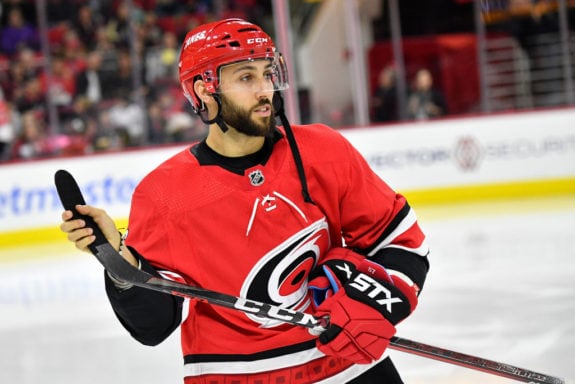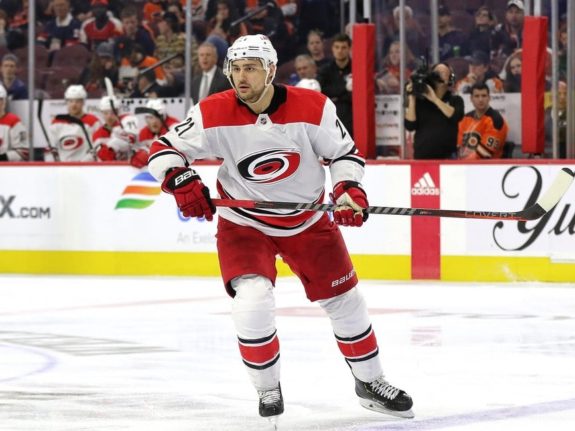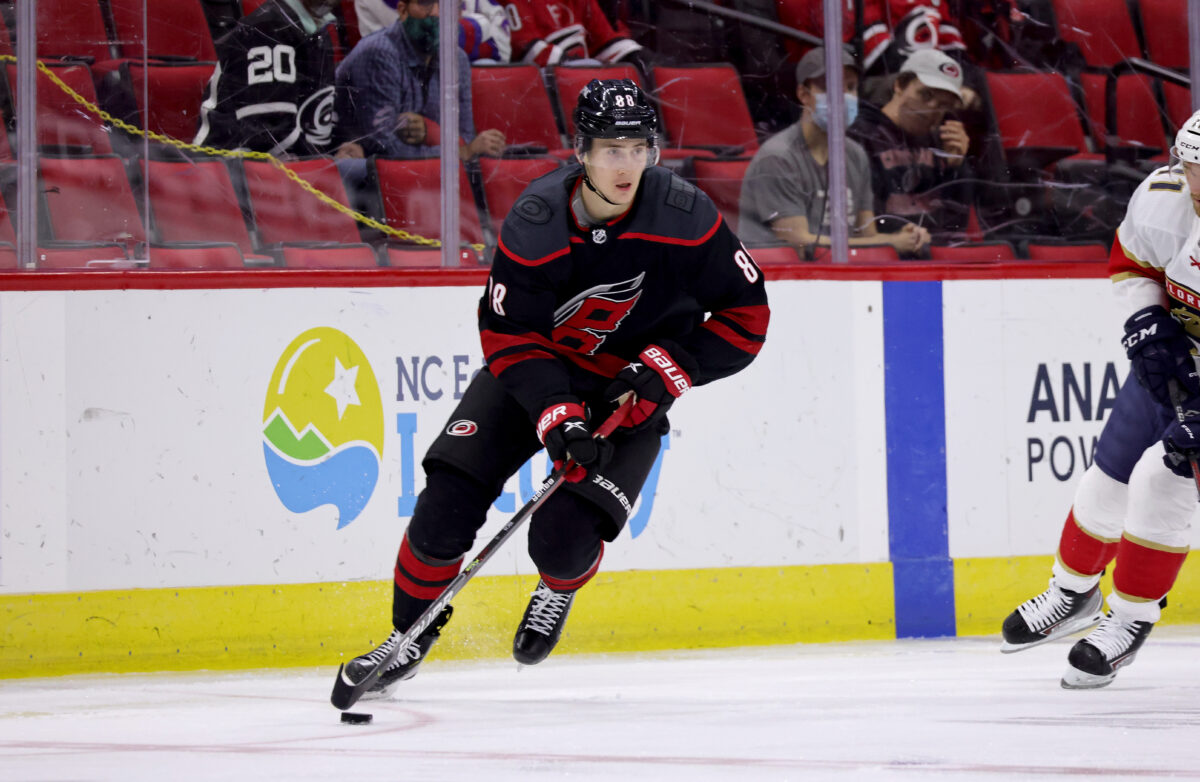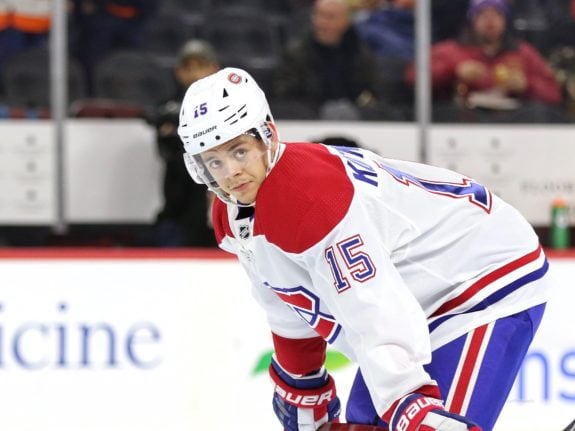As the 2021 offseason is nearing its end — less than one month away from hockey season! — it’s never too early to take a look ahead to next offseason. Anyone with an emotional attachment to the Carolina Hurricanes is used to chaos by now (Jesperi Kotkaniemi offer sheet, anyone?) and, considering the players they have that are set to be free agents next summer, we’re sure to be in for a lot more drama.
In total throughout the organization, the Hurricanes have of 27 contracted players that are heading into the final year of their contracts. Prospects who are working on breaking into the NHL and American Hockey League (AHL) depth players won’t be profiled. Others like the recently signed Ian Cole, Josh Leivo, Derek Stepan and Tony DeAngelo also won’t be featured, because they are all on one-year deals and we haven’t seen them play even a single game in a Hurricanes jersey yet. So, we’re left with five key pieces to both the team’s immediate and future success that are in need of contract extensions. Without further ado, let’s have a look at who they are.
Vincent Trocheck
Arguably the biggest unrestricted free agent decision that the Hurricanes’ front office will have to make next summer is in regards to the future of Vincent Trocheck, who’s coming off what was effectively a career year in 2020-21. His 17 goals and 43 points in 47 games were a major contributor to the team’s success throughout the regular season, although his playoff performance left a bit to be desired. Regardless, he’s proven to be a fantastic fit for this group and has emerged as the second line center that the team has been coveting for years.

Based on the factors above, it would seem like a no-brainer to assume that the Canes would want him around for the long-term, but things get a lot more complicated when you dive deeper into the situation. Trocheck will be 29 next summer, and while that isn’t particularly old, it’s a bit of a concern when you consider his injury history and his aggressive, bruising style of play as a 5-foot-10 center. You definitely need to be wary about his longevity playing the way he does, especially if his agent is asking for five-plus year term.
The arrival of Jesperi Kotkaniemi also complicates things. While he’s set to start on the wing, he’s primarly a center and projects to be a top-six player. The Hurricanes also drafted Martin Nečas as a center back in 2017, and could still have plans to transition him to center ice. Beyond those two, the team has promising youngsters like Ryan Suzuki, Jack Drury and Jamieson Rees at the position as well. And while none of these players are as effective as Trocheck is today, they’ll all be one year further along in their development next summer and any of them could be primed to take over as a cheaper, younger option in the 2C role.
As with most contracts, the Trocheck negotiation will ultimately come down to term, and money. The Hurricanes aren’t a team that’s given out long term deals to older players even despite how effective their contributions are (see: Dougie Hamilton), and love their “next man up” philosophy. On the other side, at 29, Trocheck could be looking for one more big payday in the NHL, and his best shot to get that might be on the UFA market. This will surely be one of the most fascinating storylines throughout the season. Despite the importance of the player, I’m currently not overly optimistic about a long-term pact here.
Nino Niederreiter
Since his arrival to the Hurricanes after the 2019 trade which sent Victor Rask to Minnesota, Nino Niederreiter has provided a very consistent and almost irreplaceable presence on the roster. Even when he was enduring a scoring slump throughout the 2019-20 season, he’s always played his physical, power-oriented style of game that has been sorely lacked in the Canes’ lineup. He’s big, bruising, and wins nearly every puck battle along the wall, and he’s key to holding possession with his large frame. Coming off a 20-goal performance in just 56 games in the 2020-21 season, he’s put himself in a great spot heading into a contract year.

While I firmly believe Niederreiter is currently a key player to this team’s success and especially the identity that head coach Rod Brind’Amour looks for in his guys, you need to be very careful on any long-term extension for this player. He’ll be 30 years old by the time he gets his new deal, and the heavy, physical play that he’s endured for 657 NHL games (and counting) has unquestionably taken it’s toll on him. And while I believe that he can still produce and play effective hockey even when he’s not in the same peak physical shape that he currently is, there’s a lot of unknowns involved that could make contract negotiations very complicated.
The conclusion is that we’ll have to wait and see how the season plays out before a decision can be made here. On one hand, if Niederreiter explodes offensively and can replicate his 2020-21 season, he’ll likely price himself out of the Canes’ comfort zone. On the other, if he underwhelms offensively or his power game drops off a notch, you’re left wondering if the player is even worth re-signing at age 30. It’s almost a “stuck between a rock and hard place”-type situation. I think it could eventually go either way, but I’d be pushing for a short-term contract if I was general manager Don Waddell – even if that means going a little higher on the AAV over the course of the deal.
Martin Necas
When it comes to Nečas, the debate isn’t whether he’ll be re-signed or not. The question is more along the lines of for how much, and for how long? It’s quite evident that even as a 22-year-old kid, he’s already established himself as a core player who has serious star potential and whose best is yet to come. For him, the biggest thing is finding a level of consistency on a game-to-game basis, which should continue to come with maturity. He’s shown the ability to take over games with his dynamic speed and skill combination and can genuinely look like the most dangerous player on the ice at times, and the sky really is the limit for him.

A big factor in negotiations will be how Necas’ development will trend in the forthcoming 2021-22 season. Last year, he had an impressive 41 points in 53 games playing on the team’s second line, and it’s reasonable to expect an improvement on that total. It really wouldn’t be surprising to see him hover around a point-per-game pace. A two-three year bridge deal is always in the mix, but my guess would be that the Canes would opt for max term and buy into his UFA years, the same way they did on Andrei Svechnikov’s extension. The hope being that a long-term deal will become a steal down the road, with Necas already being worth his weight in gold.
Ethan Bear
Just acquired in July via a trade with the Edmonton Oilers, Ethan Bear is headed into the final year of the two-year, $4 million deal ($2M AAV) that he’d signed with them in December. Despite coming off of a season where his offensive production dipped, Bear had pretty good possession metrics last season and looks to be a player really starting to turn a corner at age 24. It’s almost inexplicable why they were comfortable trading him – and their fans were not happy about it. But hey, when you can sign Cody Ceci for four years and trade key assets for 38-year old Duncan Keith, you always move your young, promising defensemen to make room.

The Oilers’ loss figures to be the Hurricanes’ gain here, as Bear arrives to a team with a much deeper defense core that can really deploy him in situations for success. On a recent Tracking the Storm Podcast appearance, the Canes’ Director of Hockey Operations – Aaron Schwartz – noted that the team currently views Bear as a third-pairing D with second-pair upside. If he’s able to settle in with the group and be the versatile, two-way presence that made him a fan favorite in Edmonton, I could definitely envision a long-term extension here (4-6 years) for a player who’s only just entering his prime.
Jesperi Kotkaniemi
After the Canes’ one-year, $6.1 million offer sheet to Jesperi Kotkaniemi that set the hockey world on fire, I could’ve easily put him in the “wait and see” category with the other incoming free agents. But there’s a lot of potential variables that make this situation both fascinating, and ultimately very risky. For starters, during the offer sheet’s seven-day waiting period, Habs radio host Georges Laraque reported on 91.9 Sports Radio that the Hurricanes had a long-term extension in place with Kotkaniemi, which would significantly lower his 6.1 million AAV after the season. But GM Waddell denied those claims in his first interview after the offer sheet was successful.

As per terms of the NHL’s Collective Bargaining Agreement, Kotkaniemi is unable to officially sign any contract extension with the Hurricanes before January 1, 2022, which gives both parties ample time to figure out where they stand. But where things get tricky in this situation is that, next summer; Jesperi will be due an equal qualifying offer to his current one at $6.1 million. If an extension isn’t worked out prior to the 2022 offseason, and his production doesn’t match near that dollar amount, it’s not crazy to suggest that the Canes could balk at retaining the player at a rate which would surely handicap the team, especially with other important contracts set to expire.
There are two ideal scenarios for the team in the Kotkaniemi saga. The best case is surely that both sides will agree to an extension at some point during the regular season, and extend the player long-term at a lower AAV. If that doesn’t come to fruition, the hope would be that he takes a step forward in his development blossoms into the player that management is expecting him to be, considering the price they paid to get him (2022 first and third round draft picks). In that case, qualifying him at $6.1 million would be somewhat of a no-brainer, and would give both parties the entire summer to hammer out an extension. This one will be a key storyline to follow, after gambling on talented, yet unproven, kid.
Recap
Over the past three years since entering the Tom Dundon era, it’s no secret that the Hurricanes have had difficulties retaining their UFAs. For better or worse, players like Micheal Ferland, Dougie Hamilton, Brock McGinn and Petr Mrazek have walked into free agency for no asset returns. Others like Jeff Skinner, Justin Faulk, and Joel Edmundson were unable to reach extensions and subsequently moved in trades. And when you factor in that UFA signings like Jake Gardiner, Calvin de Haan and Ryan Dzingel didn’t pan out as anticipated, it’s understandable that the team would have cold feet when dealing with aging players that are seeking long-term deals.
On the RFA front, I think it’s safe to assume that the team is in control. They’ve managed to gets guys like Sebastian Aho, Teuvo Teravainen and Andrei Svechnikov all signed long-term at seemingly below-market rate deals over the past three seasons. Necas has established himself as a core piece to the puzzle, and banking on the upside of young, yet-to-emerge talents like Kotkaniemi and Bear seems like a calculated risk worth taking. Regardless, Waddell and the rest of the Canes’ management has earned the benefit of the doubt, and there’s little reason to believe they won’t make the proper decisions with the long-term interest of the franchise in mind.